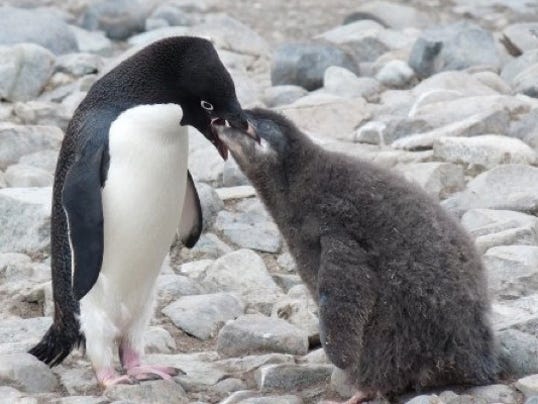When Megan Cimino looked at survival rates in Adélie penguins chicks, the University of Delaware graduate student noticed there was tremendous variability from year to year in the weight of the young birds.
Heavier birds had better survival rates in the West Antarctic Peninsula. Survival is important because the population of these penguins is in decline. So Cimino, and research adviser Matthew Oliver, a UD associate professor, initially figured it had to be food availability. “Penguins do a remarkable job of finding food for their chicks in the ocean’s dynamic environment, so we thought that the type and size distribution of food sources would impact chick weight,” Oliver said.
Instead, the scientists found climate changes and local weather – high winds, cold, rain and humidity – had the biggest impact on the young birds. While adult Adélie penguins have black and white, waterproof feathers, the young are covered with downy feathers for the first 50 to 60 days of life, Cimino said. This makes them vulnerable to cold and wet conditions.
They use more energy staying warm rather than putting on weight, she said. The variability in weather can result in a 7-ounce decrease in chick weight. That amount can determine survival and death for a penguin chick. An adult weighs 8-12 pounds when fully grown.
A new born Adélie penguin weighs about 3 ounces at birth and puts on about 100 ounces a day, if conditions are right. After 50 days of weight gain, it will weigh almost as much as its parents. Local weather is important for the young birds because penguin nests don’t protect the chicks from the conditions. Adults leave to search for food and the chicks are exposed to the elements.
The wind can also affect the waters where the adults are hunting for food, she said. It can disperse the krill, forcing parents to be at sea – and away from the nest – for longer periods. While local weather is the driving factor, that seems to be influenced by the Antarctic Oscillation, a belt of winds that shifts north and south. Depending on the oscillation shifts, it can bring warmer and wetter conditions, Cimino said.
The shifts in oscillation are highly variable ranging from weeks to months, she said. “The Adélie penguin is incredibly adaptive to the marine environment, Oliver said, “but climate ends up wreaking havoc on the terrestrial element of the species’ history, an important lesson for thinking about how we, even other species, are connected to the environment.”
Cimino, a doctoral student, looked at data from 1987 to 2011 to see penguin diet, weather and climate indices. The Western Antarctic Peninsula is of interest because temperatures have been rising there for more than 60 years. She will return to Antarctica later this month and will use tags on some birds to see how far they diveas they feed. “This will give us a sense of what is going on,” where the adults are feeding, she said.
In addition, she will use data collected at new sampling stations – sites that will be gathering information on wind, speed and direction at the surface along with current data. “We’ll be tagging adults to see where they are going,” she said.
Meanwhile, underwater robots will be gathering data in the areas where the adults are foraging, she said. “It’s important for us to understand what’s going on, especially as conditions are getting warmer and wetter, because it may give us an idea of what may happen to these penguins in the future,” Cimino said.
source



















No comments:
Post a Comment